When most people think of Missouri, they think of St Louis or random, giant objects. After all, the state is home to St Louis Arch as well as the world’s largest chess piece (which measures an impressive 9 feet, 2 inches tall). However, the Show-Me State is also famous for its natural beauty, which includes prairie, alluvial plains, and rocky plateaus. Many plants and animals live throughout the state, including bobcats and minks. Missouri is also home to many common and unique species of spiders. From lynx spiders to tarantulas, you can find many interesting spiders in Missouri. Here is a list of 10 spiders in Missouri that you may encounter during your next outing in the Show-Me State.
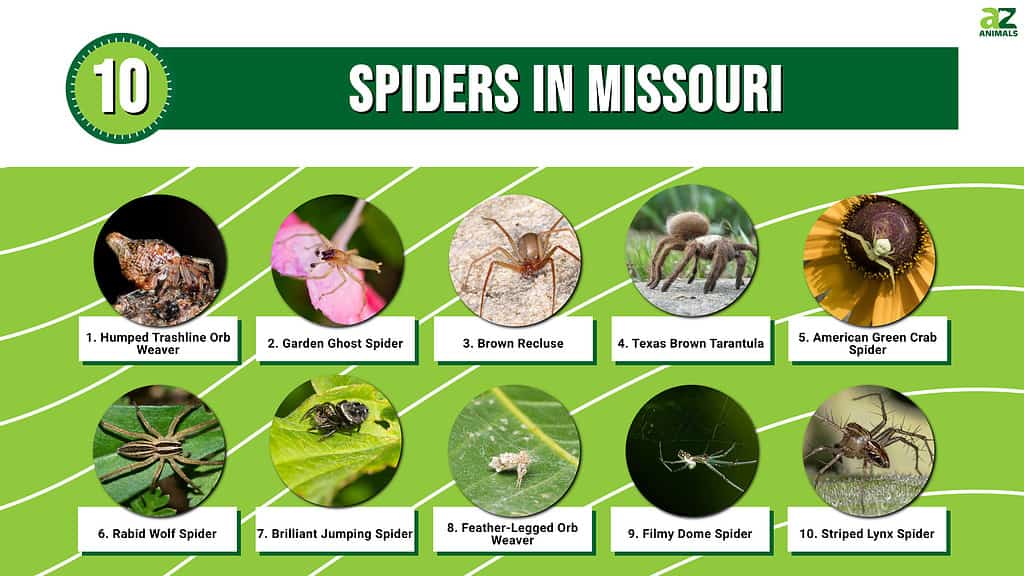
#10. Striped Lynx Spider
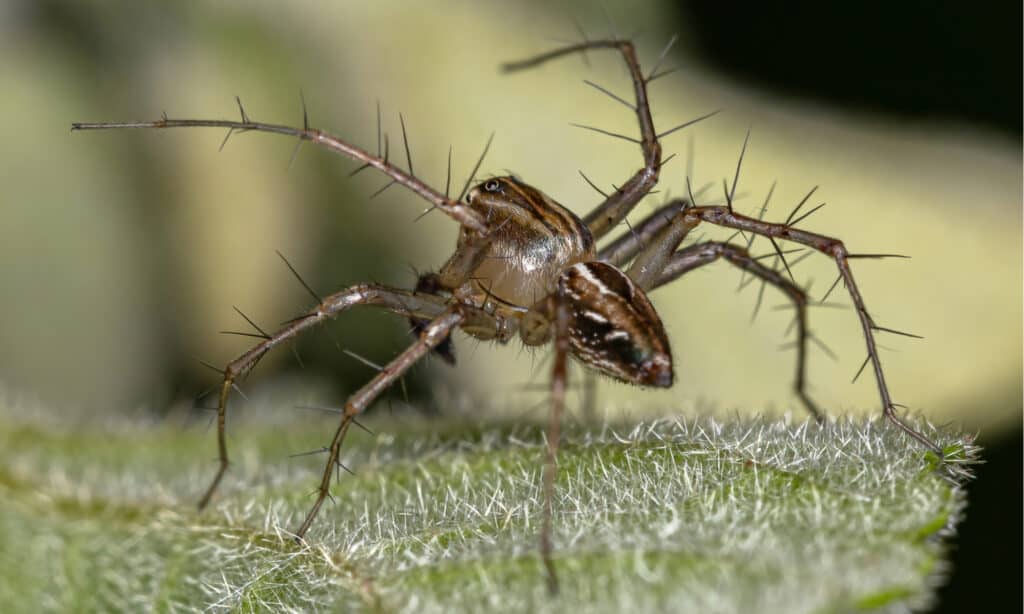
The striped lynx spider preys on many different agricultural pests.
©Vinicius R. Souza/Shutterstock.com
The striped lynx spider, Oxyopes salticus, belongs to the lynx spider family Oxyopidae. You can find these spiders in Missouri as well as throughout the eastern United States and south into Central and South America.
Adult females measure between 5 and 6 millimeters long, while adult males range in size from 4 to 5 millimeters long. Depending on the specimen, they can vary in color but typically appear predominantly cream, brown, or orange. Females generally feature stripes on their carapaces and abdomens.
You can normally find striped lynx spiders wandering throughout grasses and leafy vegetation in fields and crops. Some people consider them beneficial because they prey on major agricultural pests. They actively hunt insects rather than relying on webs to help them ensnare their prey. Due to their small size, they pose little threat to humans.
#9. Filmy Dome Spider

The filmy dome spider builds a dome-shaped web that it uses to capture its prey.
©iStock.com/Tanuza
Neriene radiata, or the filmy dome spider, is a member of the sheetweaver spider family Linyphiidae. It is one of the most common sheetweaver spiders in Missouri and is widely distributed throughout most of the United States and parts of Canada.
Even compared to many spiders, the filmy dome spider measures quite small. Adult specimens rarely measure more than 4 millimeters long, with males measuring even smaller than females. In terms of appearance, they look mostly white except for some dark markings and a brown stripe down the center of their bodies.
Like other sheetweavers, filmy dome spiders build dome-shaped webs that they use to catch prey. They hang upside-down under the dome and wait for insects such as small flies to wander into their webs. Due to their small size, their fangs normally can’t pierce through human skin, so their bite is not medically significant.
#8. Feather-Legged Orb Weaver
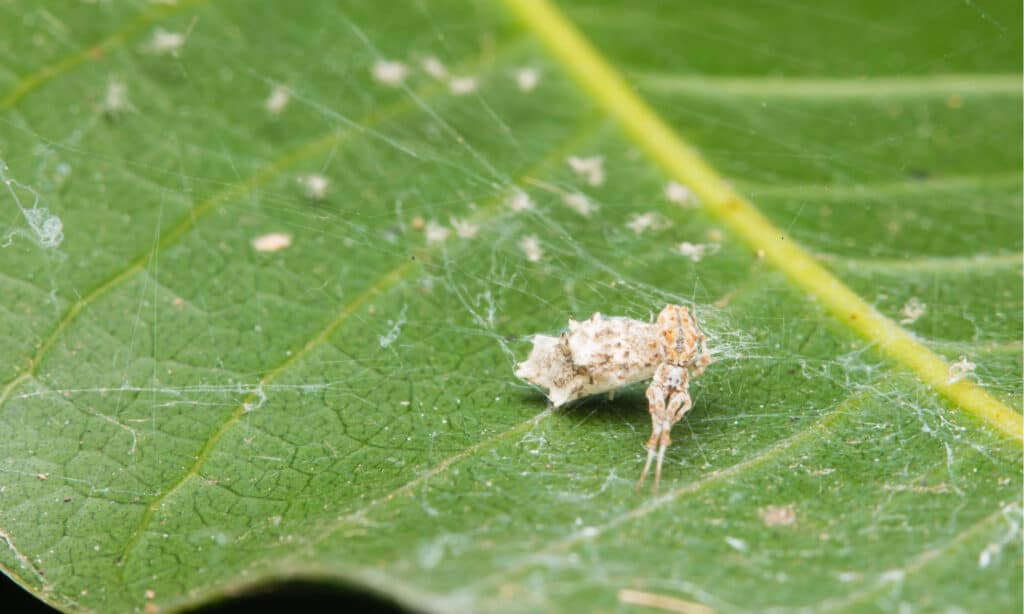
The feather-legged order weaver is the only member of its family in North America.
©Somyot Mali-ngam/Shutterstock.com
The feather-legged orb weaver, Uloborus glomosus, belongs to the cribellate orb weaver spider family Uloboridae. You can find these hairy-legged spiders in Missouri and throughout the United States. That said, it is the only member of its family found in North America.
Adult feather-legged orb weavers measure 3 to 10 millimeters long, with females measuring larger than males. As their name implies, they possess long, thick legs covered in feathery hairs. Their bodies look mostly light orange-brown, and they have large abdomens that feature prominent bumps near the upper half.
Unlike most spiders, feather-legged orb weavers did not evolve venom glands. Instead, they wrap their prey in wooly silk that they produce from their spinnerets. Although the thread isn’t sticky, the wooly texture effectively entangles prey long enough for the spiders to wrap and subdue them with their long, feathered legs.
#7. Brilliant Jumping Spider
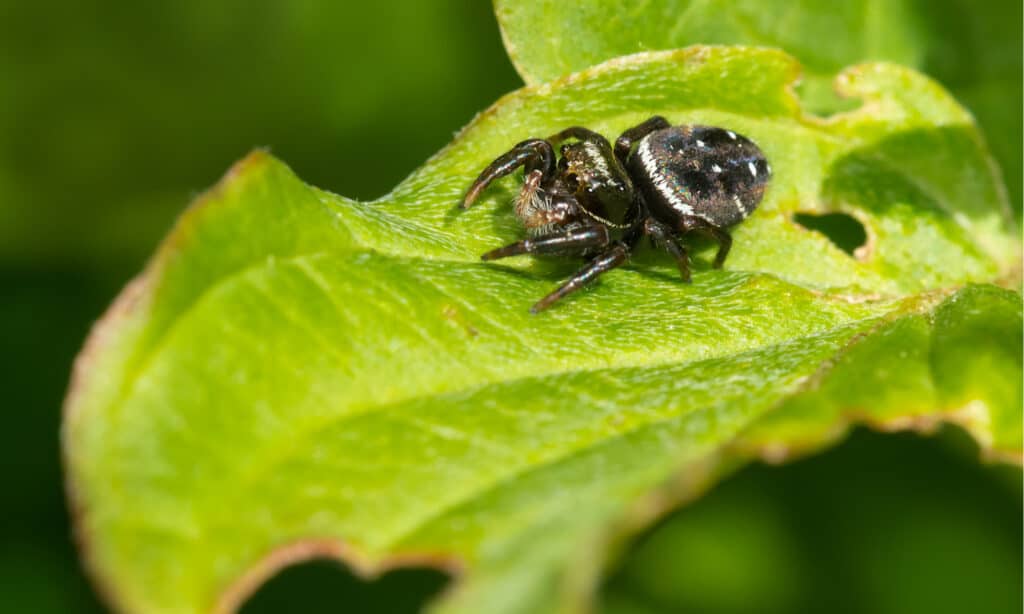
The brilliant jumping spider waits upside down near the top of plants to ambush insects wandering below.
©Paul Reeves Photography/Shutterstock.com
Phidippus clarus is more commonly known as the brilliant jumping spider. A member of the family Saltidicade, it is one of several jumping spiders in Missouri. You can frequently find this tiny hunter in fields throughout the eastern half of North America.
Female brilliant jumping spiders measure 7.9 to 12.7 millimeters long, while males measure 4.7 to 6.4 millimeters long. They possess a characteristic rectangular-shaped abdomen. Their bodies appear predominantly red or brown but may also look light yellow or brown with dark markings.
Brilliant jumping spiders actively hunt for prey instead of using webs to catch insects. They often wait upside down near the top of a plant and then jump down on top of unsuspecting insects, spiders, or other arthropods. During the mating season, females may also fight to the death with other females over males. Their bite is not medically significant.
#6. Rabid Wolf Spider

The rabid wolf spider is harmless to humans, but larger specimens can give a painful bite.
©Brett Hondow/Shutterstock.com
The rabid wolf spider, Rabidosa rabida, belongs to the wolf spider family Lycosidae. You can find this ferocious spider in Missouri and throughout the eastern half of the United States. It gets its name from its sporadic movements, which make it appear as if it is rabid.
Female rabid wolf spiders typically measure between 16 and 21 millimeters long, while males measure around 13 millimeters long. That said, the largest specimens can measure up to 25 millimeters in size. They appear predominantly yellow aside from two thin, dark brown stripes down the cephalothorax and one thick, dark stripe down the abdomen. Like other wolf spiders, they possess long, powerful legs.
Rabid wolf spiders do not construct webs to capture prey. Instead, they hunt by either ambushing or chasing down insects or other spiders. Despite their intimidating name and appearance, they pose little danger to humans.
#5. American Green Crab Spider

The American green crab spider features extremely long front legs designed to help it catch prey.
©iStock.com/Del Henderson Jr
Misumessus oblongus, or the American green crab spider, is a member of the crab spider family Thomisidae. Additionally, it ranks as the only member of its genus, Misumessus. It is widely distributed throughout the eastern half of the United States.
Adult specimens range in size from 3 to 7 millimeters long, with males on average measuring smaller than females. They get their name from their ability to walk forward, sideways, and backward like a crab. On top of that, they appear bright lime green in color aside from a thin red line done around the front of the abdomen. They possess legs that are disproportionately long in relation to their body size and slender, diamond-shaped abdomens.
American green crab spiders do not use webs for hunting and instead ambush insects that visit plants and flowers. Due to their small size, they pose little threat to humans.
#4. Texas Brown Tarantula

The female Texas brown tarantula has an extremely long lifespan and has been known to reach 40 years old in captivity.
©texas brown tarantula/Shutterstock.com
The Texas brown tarantula, Aphonopelma hentzi, also goes by the name the Oklahoma brown tarantula or Missouri tarantula. A member of the tarantula family Theraphosidae, it easily ranks as the largest spider in Missouri. It ranges throughout the southern and central United States and Mexico.
Adult Texas brown tarantulas can grow to nearly 4 inches long with their legs extended. That said, females tend to measure larger than males. In terms of appearance, they look predominantly brown but vary in color from light to dark brown.
Female Texas brown tarantulas possess extremely long lifespans and have been known to live up to 40 years in captivity. Meanwhile, males rarely live more than a year once they reach maturity. Although they rarely act aggressively toward humans, they may raise up onto their hind legs and kick small, coarse hairs located on their abdomens at potential threats.
#3. Brown Recluse
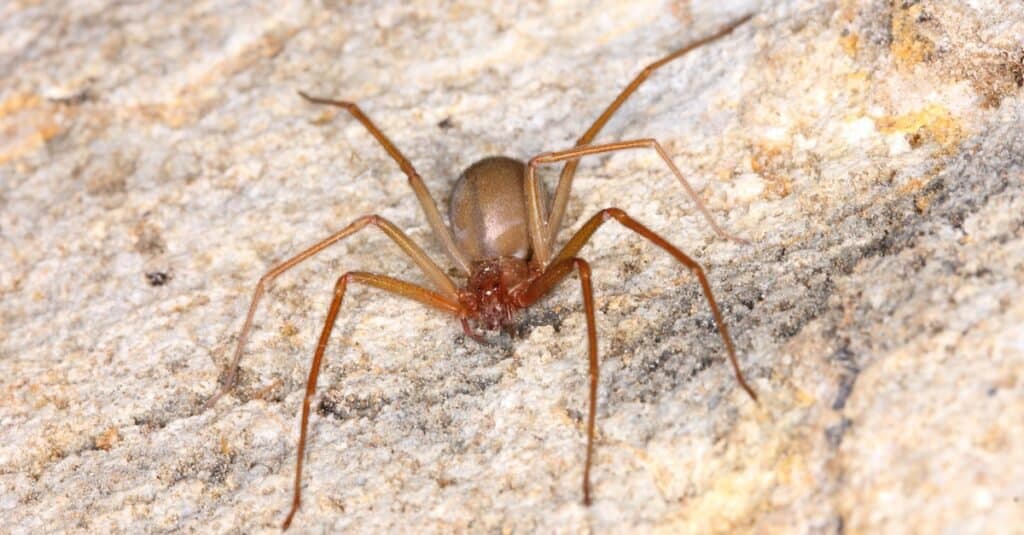
The brown recluse spider is one of the most dangerous spiders in the United States.
©Pong Wira/Shutterstock.com
The brown recluse, Loxosceles reclusa, is one of the most poisonous spiders in Missouri. Its bite occasionally requires medical attention because of its necrotic venom. Common symptoms of bites include nausea, vomiting, fever, and muscle aches. While a bite can prove fatal, the only people at serious risk are young or severely immunocompromised.
Adult brown recluse spiders measure between 6 and 20 millimeters long, with females measuring larger than males. They vary in appearance from light to dark brown or grey. You can identify them thanks to the characteristic violin-shaped marking on the bottom of the cephalothorax. This marking is why people sometimes refer to brown recluse spiders as fiddleback or violin spiders.
Unlike most web-weaving spiders, brown recluses are active hunters that leave their webs at night to hunt insects. You’ll typically encounter them in dry environments such as woodpiles, closets, garages, cellars, and sheds.
#2. Garden Ghost Spider
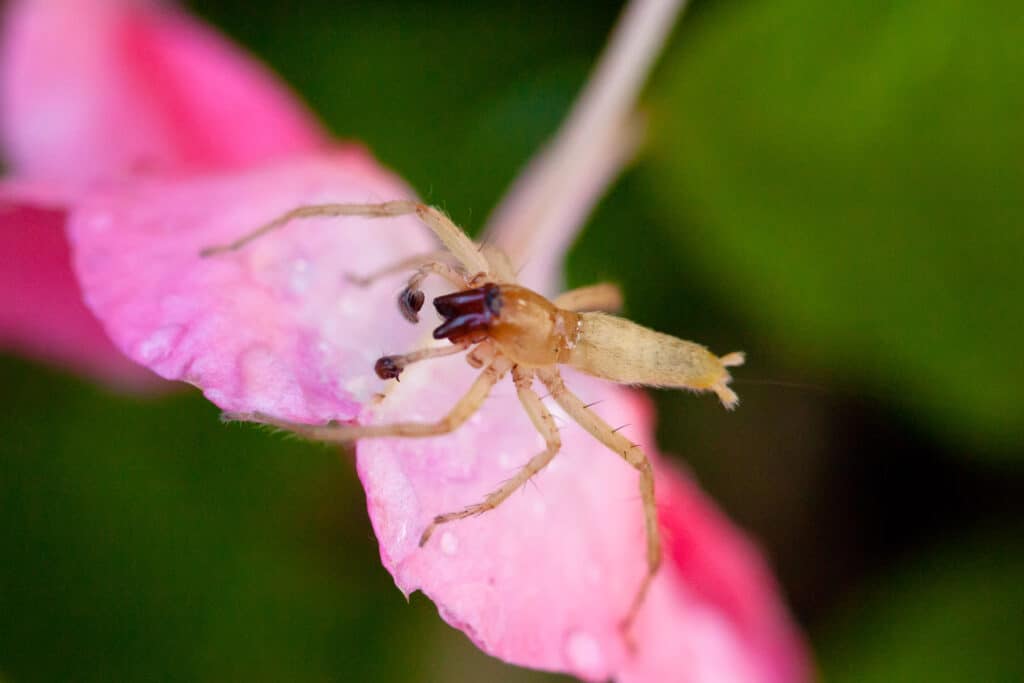
The garden ghost spider’s yellowish-green body is translucent.
©Melissa McMasters / flickr – License
Hibana gracilis is also known as the garden ghost spider. A member of the ghost spider family Anyphaenidae. You can find these spiders in Missouri as well as throughout the eastern half of the United States and parts of Canada.
Adult specimens typically measure between 6 and 12 millimeters long, with females measuring larger than males. People sometimes mistake them for yellow sac spiders since they both have long, thin abdomens and elongated spinnerets. Garden ghost spiders generally appear yellowish-green and are practically translucent. Their name, ghost spiders, refers to the fact that you can almost see through them.
Garden ghost spiders do not use webs to catch their prey. You can encounter these nocturnal hunters in wooded areas that contain plenty of insects. Aside from some minor pain, redness, or swelling, their bite poses little danger to humans.
#1. Humped Trashline Orb Weaver

The humped trashline orb weaver’s web contains everything from carcasses to eggs to detritus.
©Brett Hondow/Shutterstock.com
The humped trashline orb weaver, Cyclose turbinata, is one of two thrashline spiders in Missouri, the other being Cyclosa conica. A member of the orb weaver family Araneidae, this curious spider is originally native to the United States and Mexico. Nowadays, its range extends throughout the Caribbean as well as Central and South America.
Adult females typically measure from 3.3 to 5.2 millimeters long but can reach up to 7 millimeters in length. Meanwhile, males, on average, measure 2.5 millimeters long. They get their name from their top-shaped body, which ends in a rounded point. In terms of color, they contain a smattering of brown, black, and white markings all mixed together.
Humped trashline orb weavers often construct wheel-shaped webs made of sticky and non-sticky threads that they use to catch prey. Their webs are nicknamed “trashlines” because they contain numerous components, including carcasses, eggs, and debris.
Summary of 10 Spiders in Missouri
Here’s a recap of the 10 spider species present in the state of Missouri that we took a look at:
| Number | Spider | Scientific Name | Length |
|---|---|---|---|
| 1 | Humped Trashline Orb Weaver | Cyclose turbinata | Females: 3.3-5.2 mm but can reach up to 7 mm; males: 2.5 mm |
| 2 | Garden Ghost Spider | Hibana gracilis | 6-12 mm; females are larger than males |
| 3 | Brown Recluse | Loxosceles reclusa | 6-12 mm; females are larger than males |
| 4 | Texas Brown Tarantula | Aphonopelma hentzi | Nearly 102 mm with legs extended; females are larger than males |
| 5 | American Green Crab Spider | Misumessus oblongus | 3-7 mm; males on average are smaller than females |
| 6 | Rabid Wolf Spider | Rabidosa rabida | Females: 16-21 mm; males: 13 mm. Largest specimens can measure up to 25 mm. |
| 7 | Brilliant Jumping Spider | Phidippus clarus | Females: 7.9-12.7 mm; males: 4.7-6.4 mm |
| 8 | Feather-Legged Orb Weaver | Uloborus glomosus | 3-10 mm; females are larger than males |
| 9 | Filmy Dome Spider | Neriene radiata | 4 mm; males are smaller than females |
| 10 | Striped Lynx Spider | Oxyopes salticus | Females: 5-6 mm; males: 4-5 mm |
The photo featured at the top of this post is © iStock.com/waldru
Thank you for reading! Have some feedback for us? Contact the AZ Animals editorial team.






